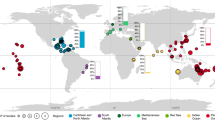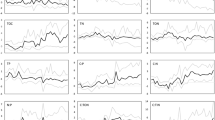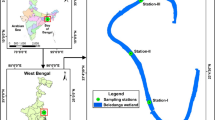Abstract
The potential interactions of grazing, nutrients and light in influencing autotroph species diversity have not previously been considered. Earlier studies have shown that grazing and nutrients interact in determining autotroph species diversity, since grazing decreases species diversity when nutrients (i.e. N or P) limit autotroph growth, but increases it when nutrients are replete. We hypothesized that increased light intensities would intensify the interactions between grazing and nutrients on algal species diversity, resulting in even stronger reductions in algal species diversity through grazing under nutrient–poor conditions, and to even stronger increases of algal species diversity through grazing under nutrient-rich conditions. We studied the effects of grazing (absent, present), nutrients (ambient, N + P enriched) and light (low light, high light) on benthic algal diversity and periphyton C:nutrient ratios (which can indicate algal nutrient limitation) in a factorial laboratory experiment, using the gastropod grazer Viviparus viviparus. Grazing decreased algal biomass and algal diversity, but increased C:P and N:P ratios of periphyton. Grazing also affected periphyton species composition, by decreasing the proportion of Spirogyra sp. and increasing the proportion of species in the Chaetophorales. Grazing effects on diversity as well as on periphyton N:P ratios were weakened when nutrients were added (interaction between grazing and nutrients). Chlorophyll a (Chl a) per area increased with nutrient addition and decreased with high light intensities. Light did not increase the strength of the interaction between grazing and nutrients on periphytic algal diversity. This study shows that nutrient addition substantially reduced the negative effects of grazing on periphytic algal diversity, whereas light did not interact with grazing or nutrient enrichment in determining periphytic algal diversity.





Similar content being viewed by others
References
Elser JJ, Acharya K, Kyle M, Cotner J, Makino W, Markow T, Watts T, Hobbie S, Fagan W, Schade J, Hood J, Sterner RW (2003) Growth rate-stoichiometry couplings in diverse biota. Ecol Lett 6:936–943
Frost PC, Elser JJ (2002a) Effects of light and nutrients on the net accumulation and elemental composition of epilithon in boreal lakes. Freshw Biol 47:173–183
Frost PC, Elser JJ (2002b) Growth responses of littoral mayflies to the phosphorus content of their food. Ecol Lett 5:232–240
Frost PC, Elser JJ, Turner MA (2002) Effects of caddisfly grazers on the elemental composition of epilithon in a boreal lake. J N Am Benthol Soc 21:54–63
Grasshoff K, Ehrhardt M, Kremling K (1983) Methods of seawater analysis, 2nd edn. Chemie, Weinheim
Hessen DO, Faerovig PJ, Andersen T (2002) Light, nutrients, and P:C ratios in algae: grazer performance related to food quality and quantity. Ecology 83:1886–1898
Hillebrand H (2005) Light regime and consumer control of autotrophic biomass. J Ecol 93:758–769
Hillebrand H, Kahlert M (2001) Effect of grazing and nutrient supply on periphyton biomass and nutrient stoichiometry in habitats of different productivity. Limnol Oceanogr 46:1881–1898
Hillebrand H, Sommer U (2000) Diversity of benthic microalgae in response to colonization time and eutrophication. Aquat Bot 67:221–236
Hillebrand H, Duerselen CD, Kirschtel DB, Pollingher U, Zohary T (1999) Biovolume calculation for pelagic and benthic microalgae. J Phycol 35:403–424
Hillebrand H, Worm B, Lotze HK (2000) Marine microbenthic community structure regulated by nitrogen loading and grazing pressure. Mar Ecol Prog Ser 204:27–38
Kahlert M (1998) C:N:P ratios of freshwater benthic algae. Archiv Hydrobiol Spec Issues Adv Limnol 51:105–114
Kahlert M, Hasselrot AT, Hillebrand H, Pettersson K (2002) Spatial and temporal variation in the biomass and nutrient status of epilithic algae in Lake Erken, Sweden. Freshw Biol 47:1191–1215
Liess A, Hillebrand H (2004) Invited review: direct and indirect effects in herbivore periphyton interactions. Archiv Hydrobiol 159:433–453
Liess A, Hillebrand H (2005) Stoichiometric variation in C:N, C:P, and N:P ratios of littoral benthic invertebrates. J N Am Benthol Soc 24:256–269
Liess A, Hillebrand H (2006) Role of nutrient supply in grazer–periphyton interactions: reciprocal influences of periphyton and grazer nutrient stoichiometry. J N Am Benthol Soc 25:632–642
Liess A, Olsson J, Quevedo M, Eklov P, Vrede T, Hillebrand H (2006) Food web complexity affects stoichiometric and trophic interactions. Oikos 114:117–125
Lubchenco J (1978) Plant species diversity in a marine intertidal community: importance of herbivore food preference and algal competitive abilities. Am Nat 112:23–39
Lubchenco J, Gaines SD (1981) A unified approach to marine plant–herbivore interactions. I. Populations and communities. Annu Rev Ecol Syst 12:405–437
Magurran AE (2004) Measuring biological diversity. Blackwell, Oxford, UK
Molau A, Alatalo JM (2003) Responses of bryophytes to simulated environmental change at Latnjajaure, northern Sweden. J Bryol 25:163–168
Nielsen KJ (2003) Nutrient loading and consumers: agents of change in open-coast macrophyte assemblages. Proc Natl Acad Sci USA 100:7660–7665
Proulx M, Mazumder A (1998) Reversal of grazing impact on plant species richness in nutrient-poor vs. nutrient-rich ecosystems. Ecology 79:2581–2592
Rosemond AD (1993) Interactions among irradiance, nutrients, and herbivores constrain a stream algal community. Oecologia 94:585–594
Rosemond AD, Mulholland PJ, Brawley SH (2000) Seasonally shifting limitation of stream periphyton: response of algal populations and assemblage biomass and productivity to variation in light, nutrients, and herbivores. Can J Fish Aquat Sci 57:66–75
Shurin JB, Borer ET, Seabloom EW, Anderson K, Blanchette CA, Broitman B, Cooper SD, Halpern BS (2002) A cross-ecosystem comparison of the strength of trophic cascades. Ecol Lett 5:785–791
Steinman AD (1996) Effects of grazers on benthic freshwater algae. In: Stevenson RJ, Bothwell ML, Lowe RL (eds) Algal ecology—freshwater benthic ecosystems. Academic, San Diego, pp 341–373
Steinman AD, Lamberti GA (1996) Biomass and pigments of benthic algae. In: Hauer FR, Lamberti GA (eds) Methods in stream ecology. Academic, San Diego, pp 295–313
Sterner RW, Elser JJ (2002) Ecological stoichiometry. Princeton University Press, Princeton
Strickland JDH, Parsons TR (1972) A practical handbook of seawater analysis. Bull Fish Res Bd Can 167
Urabe J, Kyle M, Makino W, Yoshida T, Andersen T, Elser JJ (2002) Reduced light increases herbivore production due to stoichiometric effects of light/nutrient balance. Ecology 83:619–627
Wardle DA, Bonner KI, Barker GM, Yeates GW, Nicholson KS, Bardgett RD, Watson RN, Ghani A (1999) Plant removals in perennial grassland: vegetation dynamics, decomposers, soil biodiversity, and ecosystem properties. Ecol Monogr 69:535–568
Wellnitz T, Rader RB (2003) Mechanisms influencing community composition and succession in mountain stream periphyton: interactions between scouring history, grazing, and irradiance. J N Am Benthol Soc 22:528–541
Worm B, Lotze HK, Hillebrand H, Sommer U (2002) Consumer versus resource control of species diversity and ecosystem functioning. Nature 417:848–851
Acknowledgments
We thank Jockel Liess, Jan Johansson, Elin Tranvik, Lon Willett, Karin Mattsson and the staff of the Erken laboratory for help with the experiment and the analysis of samples. The manuscript was improved by comments from Lon Willett, Lars Tranvik, Tobias Vrede, Alan Steinman and an anonymous reviewer. The project was supported by the Malméns Foundation and by the Oskar and Lili Lamms Minne foundation. A.L. was financed by the Erken Laboratory, and M.K. by the Wallenberg foundation.
Author information
Authors and Affiliations
Corresponding author
Additional information
Communicated by Dag Olav Hesse.
Rights and permissions
About this article
Cite this article
Liess, A., Kahlert, M. Gastropod grazers and nutrients, but not light, interact in determining periphytic algal diversity. Oecologia 152, 101–111 (2007). https://doi.org/10.1007/s00442-006-0636-4
Received:
Accepted:
Published:
Issue Date:
DOI: https://doi.org/10.1007/s00442-006-0636-4




